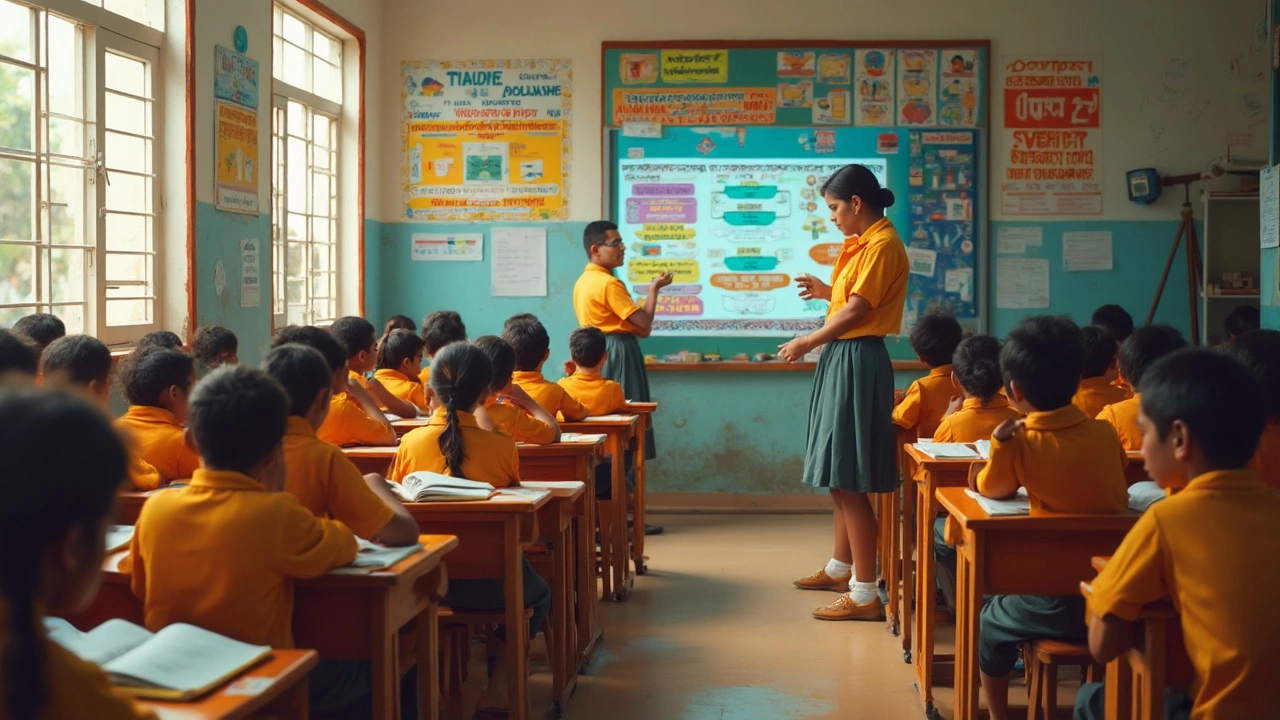Okay, so the words “CBSE syllabus” get thrown around a lot in Indian schools, but what does it actually mean? If you’re a student, parent, or just confused about how this whole system works, you’re definitely not alone. The CBSE syllabus is pretty much the backbone of what’s taught in thousands of Indian schools, both private and government. It's all planned out by the Central Board of Secondary Education, which has been running the show since 1962.
The interesting bit? This syllabus doesn’t just cover what you see in your textbook. There’s a whole strategy behind what’s chosen, how the chapters are ordered, and even the types of questions that show up in your exams. Knowing where to find this info (and how to actually use it) can make studies a lot less stressful — trust me, you’ll thank yourself at exam time.
- Understanding the CBSE Syllabus
- Subjects Covered in Each Grade
- How to Use the Syllabus Effectively
- Latest Updates and Where to Download
Understanding the CBSE Syllabus
The CBSE syllabus is basically the official playbook for what students learn each year in schools affiliated with the Central Board of Secondary Education. Forget boring memorization—CBSE actually aims to build a strong foundation for higher studies and real-world skills. So, instead of just loading your brain with facts, the idea is to make sure you actually get the concepts and can use them.
What’s inside? For every subject and grade, there’s a set list of chapters, topics, and learning goals. It doesn’t stop at the end-of-the-year exams—the CBSE syllabus also shapes how projects, assignments, and even classroom discussions happen. Teachers follow this guide to plan their lessons, and students use it to focus on what really matters for tests and board exams.
Here’s what sets the CBSE syllabus apart from other school boards:
- Uniformity: No matter where you study—Delhi, Chennai, or any other city—you’ll be taught the exact same syllabus by schools that follow CBSE.
- Up-to-date: The board tweaks the syllabus almost every year, adding new topics and cutting what’s outdated. For example, coding and data science have made their way into the curriculum recently.
- Focus on basics: There’s a strong push on subjects like Maths and Science. These are designed so that if you’re aiming for national-level exams like NEET or JEE, you’re all set.
- Skill development: It’s not just about marks—the syllabus also tries to build communication, critical thinking, and practical skills.
One thing a lot of parents and students don’t realize is that the CBSE releases a new syllabus doc every year, spelling out exactly what’s expected. Every class from grade 1 to 12 has its own detailed syllabus. Here’s a fun fact: CBSE is the board followed by over 25,000 schools, including many in Gulf countries and Singapore. That’s a lot of students learning from the same syllabus!
| Academic Year | Schools Affiliated | Countries Covered |
|---|---|---|
| 2023-2024 | 25,000+ | 28 |
Bottom line: If you really want to crack the CBSE exam, knowing the syllabus inside-out is the smartest first step.
Subjects Covered in Each Grade
If you’re checking out the CBSE syllabus for the first time, the variety of subjects might surprise you. The board has a pretty structured plan, laying out what students learn from Class 1 all the way to Class 12. That means you don’t just show up and get random topics; there’s a clear path for each grade.
Here’s a quick lowdown:
- Primary (Classes 1-5): Students usually study English, Hindi, Mathematics, Environmental Studies (EVS), and sometimes a third language (often a regional language).
- Middle School (Classes 6-8): The CBSE syllabus expands to English, Hindi, Mathematics, Science, Social Science, and a third language as part of the Three Language Formula. You’ll also see Computer Science or Information Technology popping up in many schools.
- Secondary (Classes 9-10): Core subjects are English, Hindi (or a chosen language), Mathematics, Science (that includes Physics, Chemistry, and Biology), and Social Science (History, Geography, Political Science, Economics). Some students pick up skills-based subjects like IT, Home Science, or Painting.
- Senior Secondary (Classes 11-12): Now you get to choose a stream: Science (with or without Maths/Biology), Commerce, or Humanities/Arts. Core options include Physics, Chemistry, Biology, Mathematics, Business Studies, Accountancy, Economics, Political Science, History, Geography, Psychology, Sociology, and more. English Core is mandatory. There’s a growing focus on skill-based and vocational courses too.
Want to see how it all breaks down? Here’s a quick at-a-glance table for Classes 9 to 12, since that’s where subject choices really start to matter:
| Classes | Compulsory Subjects | Optional/Skill Subjects |
|---|---|---|
| 9-10 | English, Hindi/Other Language, Maths, Science, Social Science | IT, Home Science, Painting, Music, Yoga, Artificial Intelligence* |
| 11-12 (Science) | English, Physics, Chemistry | Biology, Mathematics, Computer Science, Physical Education |
| 11-12 (Commerce) | English, Business Studies, Accountancy, Economics | Maths, Informatics Practices, Entrepreneurship |
| 11-12 (Humanities) | English, Political Science, History, Geography/Economics | Psychology, Sociology, Fine Arts, Legal Studies |
*Some optional and skill subjects depend on the school. Always check with your school’s subject offerings because the CBSE syllabus gives some flexibility but not every school can offer every subject.
Keep this structure in mind if you’re picking subjects after Class 10 — what you choose now affects your college path later. Oh, and the syllabus changes a bit every year, so downloading the latest version from the official CBSE site is always a smart move.

How to Use the Syllabus Effectively
If you want to stop feeling lost before exams, you’ve got to start treating the CBSE syllabus like your go-to guidebook. It’s not just a boring document; it tells you exactly what topics you’ll find in the textbooks, the weightage of chapters for the CBSE exam, and even what’s been dropped for the current year. Instead of jumping straight into random questions or chapters, get your syllabus in front of you first.
Here’s a clear plan to make the most out of it:
- Read the Syllabus Front to Back: Don’t just skim. Read what’s included and what isn’t. CBSE sometimes removes certain chapters or topics, and you don’t want to waste time studying deleted stuff. As of 2024-25, for example, some portions in Social Science and Science were cut out to lighten the load.
- Create a Checklist: Turn each heading and subheading into a checklist in your notebook or phone. Check them off after you finish each one. This gives you a real sense of progress instead of endless reading.
- Map the Chapters to Your Textbook: Match every point in the CBSE syllabus to the chapters in your school books. This way, you don’t miss small details the teachers expect in exams.
- Break It Down Month-Wise: Divide your topics by months or weeks. This avoids last-minute panic. Some toppers actually color-code their plans—blue for finished, yellow for revision, red for tough topics.
- Keep an Eye Out for Practical Components: For Grades 9-12, the syllabus also points out practical work and project marks. These actually make up 20% or more of your total marks in subjects like Science and Computer Applications.
- Use It for Smart Revision: Before exams, use your syllabus instead of just re-reading your book. Make sure you can at least attempt every part mentioned on it, since the CBSE exam questions are pulled right from these topics.
Want to see how topics are actually split on the exam paper? Here’s a sample from the 2024 CBSE Class 10 Science mark distribution:
| Unit | Marks |
|---|---|
| Chemical Substances | 25 |
| World of Living | 23 |
| Natural Phenomena | 12 |
| Effect of Current | 13 |
| Natural Resources | 7 |
This table makes it clear—spend more time on units that carry higher marks. If you use your CBSE syllabus as your roadmap, everything about planning your studies gets easier, and you avoid nasty surprises right before your CBSE exam.
Latest Updates and Where to Download
If you’re following the CBSE syllabus in India, don’t just assume last year's textbook will have you covered. The Central Board of Secondary Education tweaks the curriculum every year. These updates might seem small (a reordered chapter, a dropped topic, or new practice questions), but they can totally change what shows up on your board exams. In 2024-25, for example, CBSE trimmed some content from Maths and Social Science to make life easier post-pandemic. A few topics were added back based on feedback from teachers.
Here’s a quick look at some notable changes for 2025:
- Chemistry practicals for class 12 got a new grading pattern. Focus shifted to practical application.
- English syllabus now includes a section on creative writing with digital skills—think emails, blogs, not just letter-writing.
- More MCQs in class 10th Science paper, so get used to practicing those.
- Class 9 and 10 Social Science: Some overlapping chapters removed to avoid repetition.
If you want the latest and most accurate CBSE syllabus, the best source is always the official CBSE website (cbseacademic.nic.in or cbse.gov.in). Don't trust random PDFs floating around WhatsApp. Here’s a quick step-by-step guide to get exactly what you need, straight from the source:
- Go to cbseacademic.nic.in on your phone or laptop.
- Click on the “Curriculum” tab. You’ll see options for Secondary (classes 9-10) and Senior Secondary (classes 11-12).
- Pick your class and subject. All the latest PDFs get updated here every April or whenever there’s a big change.
- Download and save for offline reference. You’ll see exactly what topics are in, what’s out, and marking schemes for board exams.
Here’s a sample of important syllabus updates for the 2024-25 session:
| Class | Subject | Key Change |
|---|---|---|
| 10 | Science | More MCQs, deleted some theory chapters |
| 12 | Chemistry | Practical exam pattern changed |
| 10 | Social Science | Chapter on Disaster Management trimmed |
Pro tip: Download the latest CBSE syllabus at the start of the session, print it, and check it off as you finish chapters. It’s the easiest way to be exam-ready and not get caught off guard when something’s missing (or suddenly added) to your curriculum.
